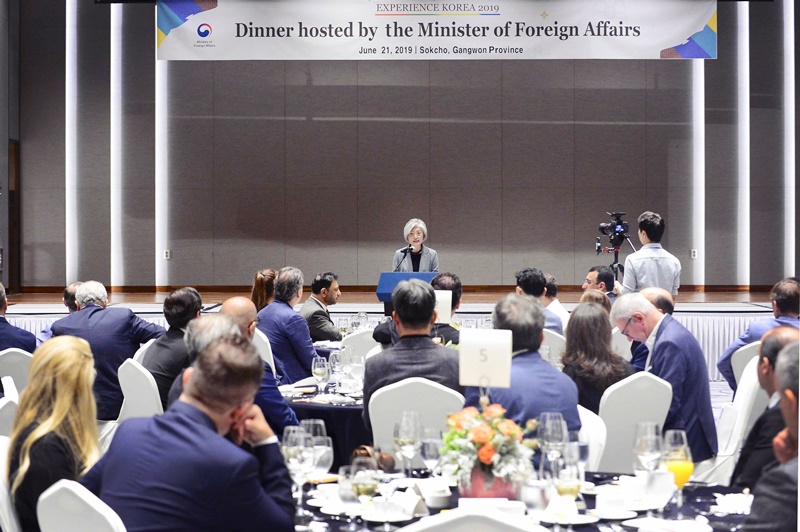-
About the Ministry
About the Ministry
- Press
- Countries & Regions
- Policy Information
- Life In Korea
Minister
- Notices
- Ministry News
- Press Releases
- Press Briefings
- Speeches & Published Materials
- Newsletter Service
- Diplomatic White Paper
[Former] “Experience Korea 2019” Welcoming Remarks (6.21.)
- Date
- 2019-06-26
- hit
- 13335

“Experience Korea 2019” Welcoming Remarks
By the Minister of Foreign Affairs
On the occasion of Dinner for the Diplomatic Corps
Your Excellency Mohamed Salim Al-Harthy,
Dean of the Diplomatic Corps,
Excellencies,
Distinguished Guests, Ladies and Gentlemen,
Good evening.
It’s wonderful to be with many of you again, so soon after your first annual gathering of the Heads of Diplomatic Missions in May. It is all the more enjoyable as many of are joined by your spouses today.
I am indeed very pleased and delighted to welcome you to dinner this evening, at this beautiful eastern coast of Gangwon Province.
This year, the annual Diplomatic Corps excursion organized by the Foreign Ministry has been re-named “Experience Korea”. The new name reflects our wish to provide you with opportunities for firsthand, in-depth experience of Korea’s diversity in history, culture, nature and industry in different parts of the country.
As the first attempt under the new banner this year, we’ve arranged a two-day excursion to Gyeonggi and Gangwon Provinces to get a glimpse of Korean traditional culture, to witness the changing security landscape on the Korean Peninsula, and to take a close look at Korea’s automotive industry and its latest technology.
Thus, as the first leg of the excursion this morning, you visited the Hyundai Kia Motors R&D Center in Hwaseong, one of the leading laboratories in the world’s emerging hydrogen vehicle industry.
I hope the visit gave you a glimpse into Korea’s ambition to nurture the hydrogen economy, as reflected in the national policy and roadmap announced in January to shift toward emission-free energy resources. The plan is to actively nurture the growth of related sectors so as to ramp up the production of hydrogen vehicles and fuel cells, and eventually establish an eco-system for full-fledged hydrogen production and distribution.
Excellencies, Distinguished Guests, Ladies and Gentlemen,
Gangwon Province is Korea’s most mountainous region. Steep mountains and hills covered with rich forestry take up 80 percent of its land. The forests function as the lungs of the country, and the water flowing from the province provides drinking water to some 25 million citizens in Seoul and its surrounding metropolitan area.
In addition to its beautiful landscape and seascape, the province is also home to numerous heritage sites and tourist attractions, including the Buddhist Temple Naksansa that you visited this afternoon.
As you know, in April, Gangwon Province suffered a devastating wildfire which quickly escalated to a national disaster. The fire was soon contained, thanks to the swift response of all relevant authorities and local residents, but the area’s tourism industry and regional economy were seriously damaged by the fire, and the recovery has been challenging.
So we are encouraging people to pay more visits to this region to help boost the local economy. I am sure our visit today is greatly appreciated by the local people and governments and I do hope many of us will come back to further explore the countless attractions of the region.
Ladies and Gentlemen,
Gangwon Province also saw some of the most brutal battles during the Korean War. When the guns stopped with an armistice in July 1953, it ended up housing roughly three fifths of the Military Demarcation Line between the South and North.
But a dramatic change in this profile has been taking shape recently, and the province has become a harbinger of inter-Korean exchanges and cooperation in our journey towards lasting peace on the Korean Peninsula, starting with the Pyeongchang Winter Olympic and Paralymic Games in February and March last year. The region is becoming a destination for “peace tourism”, where visitors can reflect on the historical roots and the value of peace and security on the Korean Peninsula.
We all know of the landmark diplomatic engagements of last year that have turned the geopolitical tide on the Korean Peninsula from one of increasing tension to one of dialogue for denuclearization and peace. So, I will not repeat the stories. But let me just note that that the South-North military agreement of September 19 last year and its faithful implementation has led to greatly reduced armament and tension and the chance of accidental clashes along the DMZ.
Tomorrow morning we are going to take a walk along the 고성 stretch of the “DMZ Peace Trail”. This part of the land had been out of the public’s reach for more than 65 years. It was opened up to the public in April this year to mark the first anniversary of the April 27th inter-Korean Summit in Panmunjom. I hear it offers a stunning view of the coastline and the land stretching north beyond the Military Demarcation Line. I just hope the weather cooperates.
My Government is determined to continue down the current path to realizing complete denuclearization and permanent peace on the Korean Peninsula. Let me take this opportunity to ask for your abiding support for our efforts.
Excellencies,
In closing, I would like to express my heartfelt thanks to all of you for your noble endeavors to strengthen the bonds of mutual cooperation and friendship between Korea and your countries. I and my colleagues in the Foreign Ministry are happy and honored to work with you so that your time here can be most fruitful, rewarding, and memorable.
And with that, I would like to propose a toast to your health, to our friendship and our walk tomorrow, and to peace on the Korean Peninsula and in the world. Cheers!




